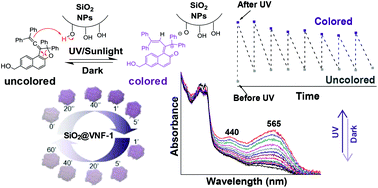A novel generation of hybrid photochromic vinylidene-naphthofuran silica nanoparticles through fine-tuning of surface chemistry†
Abstract
Novel photochromic 1-vinylidene-naphtho[2,1-b]furan derivatives (VNF-1 and VNF-2) were successfully anchored onto silica nanoparticles (SiO2 NPs) through direct adsorption (SiO2@VNF-1) and covalent post-grafting (SiO2@VNF-2). SiO2 NPs with different sizes (15 ± 3 and 123 ± 7 nm) and surface chemistry (pHpzc in the range of 5–9) were used, offering a wide range of possibilities to fabricate tailor-made photochromic materials. The characterization of VNF-based SiO2 NPs confirmed the efficient VNF immobilization and the integrity of both organic and inorganic components. The photochromic behavior of these new nanoparticles indicates that silica surface acidity and the type of VNF immobilization strategy (adsorption vs. covalent grafting) were crucial factors for the occurrence of photochromism in the VNF-based SiO2 NPs. Upon UV (λ = 365 nm) or sunlight exposure for 1 min, only the SiO2@VNF-1 nanomaterials prepared by direct VNF adsorption onto SiO2 NPs with pHpzc ≈ 6.0 showed direct and reversible photochromic properties, developing fast (in seconds) and intense salmon and violet coloration, with high values of total color difference ( ) and optical densities (ΔOD = 0.14–0.25). In contrast, all nanomaterials prepared by covalent grafting of VNF-2 onto SiO2 NPs (SiO2@VNF-2) did not exhibit photochromism. In the case of the photochromic SiO2@VNF-1 NPs, the decoloration process followed a bi-exponential decay with fast rate constants (k1 = 1.6 × 10−1–1.6 min−1 and k2 = 9.1 × 10−3–1.3 × 10−1 min−1), which were responsible for the loss of coloration in less than 10 min. Furthermore, they presented very good resistance to fatigue, showing reversibility between the colored/uncolored states without significant loss of their performance for at least 8 successive UV/dark cycles.
) and optical densities (ΔOD = 0.14–0.25). In contrast, all nanomaterials prepared by covalent grafting of VNF-2 onto SiO2 NPs (SiO2@VNF-2) did not exhibit photochromism. In the case of the photochromic SiO2@VNF-1 NPs, the decoloration process followed a bi-exponential decay with fast rate constants (k1 = 1.6 × 10−1–1.6 min−1 and k2 = 9.1 × 10−3–1.3 × 10−1 min−1), which were responsible for the loss of coloration in less than 10 min. Furthermore, they presented very good resistance to fatigue, showing reversibility between the colored/uncolored states without significant loss of their performance for at least 8 successive UV/dark cycles.



 Please wait while we load your content...
Please wait while we load your content...